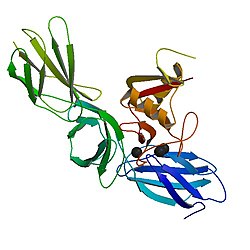
Proteoglycans are proteins[1] that are heavily glycosylated. The basic proteoglycan unit consists of a "core protein" with one or more covalently attached glycosaminoglycan (GAG) chain(s).[2] The point of attachment is a serine (Ser) residue to which the glycosaminoglycan is joined through a tetrasaccharide bridge (e.g. chondroitin sulfate-GlcA-Gal-Gal-Xyl-PROTEIN). The Ser residue is generally in the sequence -Ser-Gly-X-Gly- (where X can be any amino acid residue but proline), although not every protein with this sequence has an attached glycosaminoglycan. The chains are long, linear carbohydrate polymers that are negatively charged under physiological conditions due to the occurrence of sulfate and uronic acid groups. Proteoglycans occur in connective tissue.
- ^ Proteoglycans at the U.S. National Library of Medicine Medical Subject Headings (MeSH)
- ^ Gerhard Meisenberg; William H. Simmons (2006). Principles of medical biochemistry. Elsevier Health Sciences. pp. 243–. ISBN 978-0-323-02942-1. Retrieved 6 February 2011.